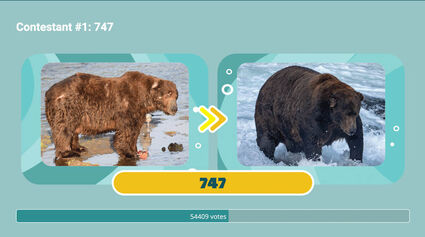Fat Bear Voting Ends with a Winner!
Some of the largest brown bears on Earth make their home at Brooks River in Katmai National Park, Alaska. Brown bears get fat to survive, and Fat Bear Week is an annual tournament celebrating their success in preparation for winter hibernation.
Fat Bear Week 2022 runs from October 5 to October 11. Cast votes decides who is the fattest of the fat. The annual poll saw thousands of people glued to webcams watching bears in Alaska stuff themselves with salmon as they ready for hibernation.
The creatures in Katmai State Park "could easily be eating 100 pounds (45 kilograms) or more of fish in a day," former park ranger Mike Fitz, who thought up the vote, told AFP.
"It's common for them to eat 20 or more salmon in a day."
During five months of deep sleep, the bears do not wake to eat, drink, or even go to the toilet, emerging famished -- and a lot thinner -- in the spring.
Defending champion Otis, who has four titles to his name, tips the scales at around 1,000 pounds. This year, he faced a hefty challenge for the overall crown from a bear dubbed 747, named after Boeing's enormous plane, and himself a former champ.
The contest, which takes place online, and of which the bears are probably unaware, began in 2014 with just a few thousand people voting. By last year, it had become a titan in its own right, with more than 800,000 ballots cast.
"It's an event to raise awareness for brown bears in Alaska and in Katmai National Park," said Fitz, who now works as a naturalist for environmental NGO Explore.
"And hopefully through that awareness, people come to care for the animals."
That awareness is crucial to Fitz's larger aim of helping to prevent environmental damage.
"On much of the west coast of North America, salmon runs are just hanging on by a thread," he said.
"We're doing very poorly in parts of California, in Oregon and Washington due to habitat loss and barriers to their migration like dams.
"And climate change is exacerbating those things with drought and heat waves."
Fat Bear Week runs as a single elimination tournament. For each match-up, people vote for the bear they believe best exemplifies fatness. The bear with the most votes advances to the next round. Only one will be crowned champion of Fat Bear Week.
Participates select their choice by clicking or tapping on the photos of the bear. That bear will then be outlined in blue. Then enter your email where prompted. You know that you have successfully voted if you see the total votes for each bear.
When Fat Bear Week roles around next year - who should you vote for?
Your Fat Bear Week vote can be based on many factors. You may want to consider the tremendous growth spurts experienced by younger bears. Subadult (teenage) bears and cubs, for example, grow proportionally more each year than even the biggest adults. Perhaps you want to weigh your vote toward bears with extenuating circumstances such as a mother's cost of raising cubs or the additional challenges that older bears face as they age. A mother bear's ability to gain weight is harder compared to other bears because she must provide for herself and the welfare of her cubs. An older bear can have difficulty finding access to its preferred fishing spots due to competition with larger and younger bears. You can also vote for the bear you think is the simply the largest and fattest. In short, Fat Bear Week is a subjective competition. Be sure to campaign for your favorite candidate using #FatBearWeek on social media. Download your blank bracket to predict your own fat bear winner.
Why are fat bears important?
Katmai's brown bears are at their fattest in late summer and early fall. It is the end-product of their summer-long effort to satisfy their profound hunger and prepare for winter hibernation. During hibernation, bears do not eat or drink and can lose one-third of their body weight. Their winter survival depends on accumulating ample fat reserves before entering the den.
To get fat, bears gorge on the richest and most easily obtainable foods they can find. In Katmai National Park, that most often means salmon. Dozens of bears gather at Brooks River to feast on salmon from late June until mid October. Perhaps no other river on Earth offers bears the chance to feed on salmon for so long.
Fat bears exemplify the richness of Katmai National Park and Bristol Bay, Alaska, a wild region that is home to more brown bears than people and the largest, healthiest runs of sockeye salmon left on the planet.
With another Fat Bear Week in the history books and one of the United States' largest national parks filled with fat, successful bears, it's time to celebrate the summer that was and look toward the future of Katmai National Park and Preserve. Join explore.org's resident naturalist Mike Fitz and documentary filmmaker and former Katmai ranger Naomi Boak for this celebration of Katmai National Park, its famous brown bears, remarkable salmon, and the Katmai's Conservancy's efforts to support the park. Watch on explore.org's Brooks Live Chat channel.









Reader Comments(0)